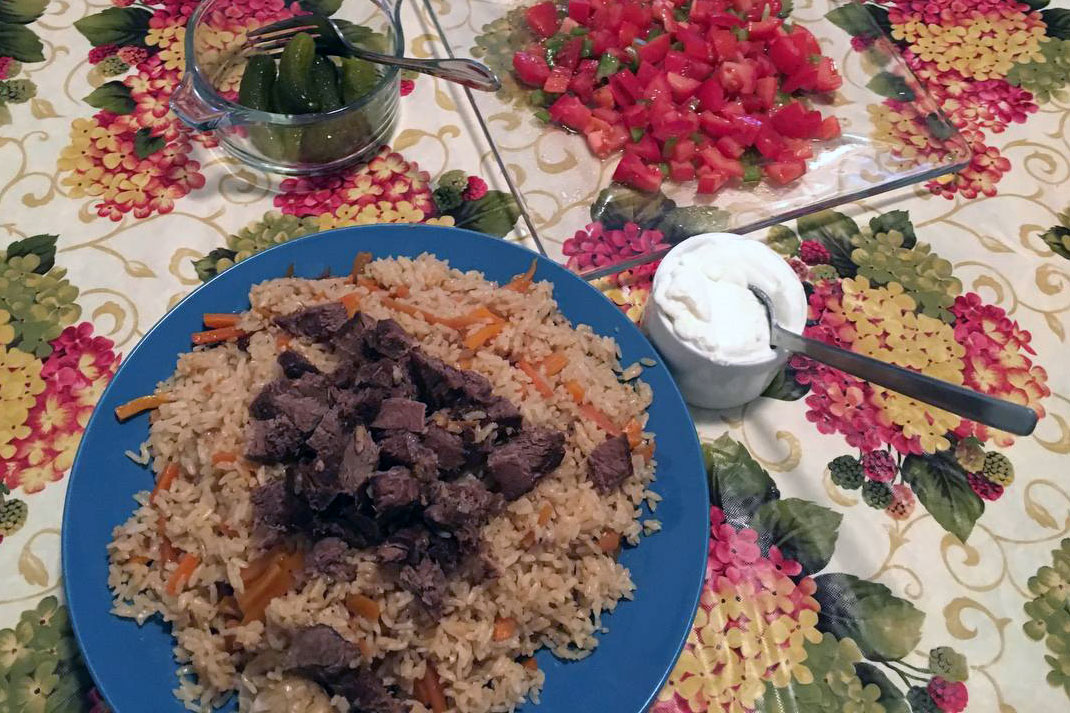During World War II, my maternal grandparents immigrated to the Turkmen Soviet Socialist Republic (now Turkmenistan) from a small village in Russia and have lived ever since in Ashgabat, the Turkmen capital. As a result, my family’s Russian culture intertwined with the very diverse culture of Turkmenistan, where people of Armenian, Azerbaijani, Kazakh, Turkish, Ukrainian, and Uzbek descent—as well as Russian, Turkmen, and others—have come together to share customs and a common language.
But if I had to choose the one thing that best unites us all in this diverse community, it would be food. One of the core dishes in Turkmen cuisine that was always on our tables during New Year’s and other festivities was pilaf (in Turkmen) or плов (in Russian). It is a traditional Central Asian dish of meat and rice mixed with carrots, onions, and spices.
Every country in Central Asia—consisting of all countries with the suffix -stan, which means “the land of” in Persian—has adopted pilaf in its own way by using different spices while leaving the core (meat and rice) the same. As far as I know, I have never met a woman in Turkmenistan who didn’t know how to cook pilaf. Typically, Turkmen men butcher the lamb or an adult sheep for pilaf, and women cook it in a large cauldron. This way, every family member gets enough pilaf and even to share with neighbors and friends.
Turkmens don’t cook pilaf every day, but rather save it for special occasions such as weddings, birthdays, funerals, and holidays. Being away from Turkmenistan—where pilaf’s special ingredients and utensils may be unavailable—makes it difficult to replicate the exact cooking process. For example, Turkmens usually cook pilaf with mutton fat instead of vegetable oil. But because mutton fat needs to come from a freshly butchered lamb or mutton, it is not readily available in the United States.
Another must-have for Turkmen pilaf is a cauldron. Many of my friends from Turkmenistan buy a cauldron upon coming to the United States because it allows the meat to cook longer and become more tender.
Because it is hard to find the exact things Turkmens use to cook pilaf, all Turkmen students in the United States try their best to find substitutes for certain ingredients or cookware. In my case, rather than looking for mutton fat, I have opted for vegetable oil and other ingredients that are easier to find.
It took me a couple of years to learn how to cook Turkmen pilaf properly. Because it tastes and smells like home to me, I try to cook it at least a couple of times a year, especially at New Year’s, when my friends gather to celebrate. As I write this, I nostalgically recall the times I ate Turkmen pilaf with my family in Turkmenistan and American and Turkmen friends in the United States. This year, for our New Year’s Eve celebration, I cooked Turkmen pilaf for my new friends from Belarus who just recently moved to the United States for college. It was a good way to foster friendships and share a piece of my culture with them.

Yuliya’s Turkmen Pilaf
Serves 6 or 7
Ingredients
2 pounds meat (beef, lamb, or chicken)
2 tablespoons salt
Black pepper to taste (optional)
1 1/5 cups vegetable oil, or mutton fat if available
1 large onion, sliced in rings
5 large carrots, julienned
4 1/2 cups basmati rice, rinsed
7 cups water
Preparation
Cut the meat of your choice into bite-sized chunks. Add salt (and pepper, if using) and mix well with your hands.
Heat the vegetable oil in a large, uncovered pot over medium heat. Add the meat chunks and sauté until lightly browned. Add onion. When the onion begins to soften, add carrots and sauté for 5 minutes until they soften.
While the meat and vegetables cook, rinse the basmati rice to remove the starch. When the water runs clear, layer the rice to cover all the meat and vegetables rather than combining everything.
Pour the water over the rice and cook on high heat until the water boils. Lower the heat to medium, cover the pot, and let it cook for another 15 minutes. When the rice has absorbed all the water, turn off the heat. Place a paper towel over the top of the pot, held in place by the lid to absorb excess moisture. Let stand for 10 minutes and serve warm.

Yuliya Gluhova is a former intern at the Center for Folklife and Cultural Heritage from Ashgabat, Turkmenistan. She studies anthropology and political science at Mississippi State University.


